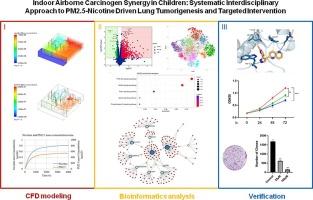儿童室内空气致癌物协同作用:pm2.5 -尼古丁驱动的肺肿瘤发生和靶向干预的系统跨学科方法
IF 2.9
Q2 TOXICOLOGY
引用次数: 0
摘要
室内空气环境已成为影响儿童健康和安全的重要环境因素,其中尼古丁和PM2.5这两个常见的组合因素已成为室内诱发儿童肺癌的致病因素。为了揭示其具体机制,我们将环境工程、生物信息学和计算生物学等多学科方法相结合,建立了系统环境信息医学工程(SEIME)模型。我们首先建立了一个全面的计算流体动力学(CFD)模型,随后将其与GEO数据库、TCGA数据库、单细胞在线数据库和分子对接分析的数据相结合,以增强我们的研究框架。CFD结果显示,室内PM2.5和尼古丁浓度显著高于WHO《全球空气质量指南》推荐值15µg/m3和1µg/m3。同时,生物信息学结果表明,MAPK和PI3K-Akt是诱导儿童非小细胞肺癌(NSCLC)的重要信号通路。此外,GADD45A和NPAS2是影响儿童NSCLC的关键靶点。随后进行药物重定位和分子对接试验,更重要的是筛选相关的小分子靶向药物。因此,本研究建立了一种新的跨学科分析模型——seime,利用环境信息医学工程解决多因素影响下的环境疾病模型,为分子靶点筛选和疾病治疗提供理论依据。本文章由计算机程序翻译,如有差异,请以英文原文为准。

Indoor airborne carcinogen synergy in children: systematic interdisciplinary approach to PM2.5-nicotine driven lung tumorigenesis and targeted intervention
The indoor air environment has become an essential environmental factor affecting children’s health and safety, among which nicotine and PM2.5, two common combined factors, have become pathogenic factors in indoor area that induce lung cancer in children. In order to reveal the specific mechanism of that, we developed the model of Systematic Environmental Information Medicine Engineering (SEIME), which combines environmental engineering, bioinformatics, and computational biology multidisciplinary approaches. We initially developed a comprehensive computational fluid dynamics (CFD) model, which was subsequently integrated with data from the GEO database, TCGA database, single-cell online databases, and molecular docking analyses to enhance our research framework. CFD results revealed that indoor concentrations of PM2.5 and nicotine were significantly higher than the recommended values of 15 µg/m3 and 1 µg/m3 in the WHO Global Air Quality Guidelines. Meanwhile, bioinformatics results indicated that MAPK and PI3K-Akt were important signaling pathways for inducing non-small cell lung cancer (NSCLC) in children. In addition, GADD45A and NPAS2, as key targets affecting children’s NSCLC, were identified. Subsequently, drug repositioning and molecular docking assays were conducted, and more importantly, related small molecule targeted drugs were screened. Therefore, this study has set up a new interdisciplinary analysis model-SEIME, using environmental information medicine engineering to solve environmental disease models under the influence of multiple factors, and providing theoretical basis for molecular target screening and disease treatment.
求助全文
通过发布文献求助,成功后即可免费获取论文全文。
去求助
来源期刊

Current Research in Toxicology
Environmental Science-Health, Toxicology and Mutagenesis
CiteScore
4.70
自引率
3.00%
发文量
33
审稿时长
82 days
 求助内容:
求助内容: 应助结果提醒方式:
应助结果提醒方式:


